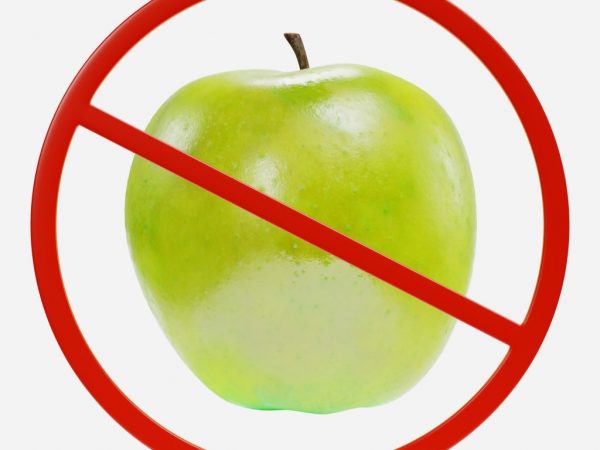Signs of an apple allergy
An apple is a healthy fruit. It contains a large amount of vitamins, amino acids and other components useful for the body. For this reason, apple allergy is rarely diagnosed.

Signs of an apple allergy
Symptoms
Like any other specific reaction to an external stimulus, allergy to these fruits has its own symptoms. It belongs to the food type, and its effect extends to the organs of the digestive system and the skin.
In adults
Symptoms can be different, depending on which body system is affected. In addition, it depends on the degree of development of the reaction. Allergy to apples in adults can manifest itself in the form of the following symptoms:
- the most harmless manifestations that are easily removed are oral. Burning, itching, hyperemia in the mouth begins, the lips may swell a little and redden. Cough, sore throat may occur. Such symptoms are not dangerous with bad consequences, because they are usually easy to relieve. They usually appear 5-10 minutes after eating the fruit or while chewing the first piece. It is enough just to remove the remnants of the apple from the mouth and rinse it with water;
- the second type of signs is cutaneous. A rash, hyperemia, blisters, urticaria, itching, edema appear. It all depends on the degree of allergy. Such symptoms usually appear an hour after taking the fruit, but some hypersensitive people may have it instantly if they just pick up the apple;
- the third type concerns the digestive system. The stomach and intestines are suffering. Heartburn, nausea, vomiting, spasms, and stool disorders appear. These symptoms can occur if the gastric juice does not break down all the components that are in the apple.
Also, the reaction can affect the respiratory system. Shortness of breath, runny nose, coughing, sneezing, itching and burning in the nose will begin. This symptomatology is dangerous because if you do not provide help to a person in time, he may suffocate.
The most serious reaction is anaphylactic shock, which rarely happens but requires immediate help.
In children
The symptomatology of apple allergy in a child and an adult is somewhat different. This is because in infants the gastrointestinal tract is still being formed and the stomach cannot always completely digest the fruit.
It is better to give the first complementary food with an apple to children after six months, because both the fruit and the juice from it in young children can cause a negative reaction of the body.
Diathesis is a characteristic symptom of fetal allergy in children. It is a small, reddish rash on the skin. More often it is localized on the cheeks and arms of babies. Upset stomach is another sign. Colic, bloating, vomiting, and loose stools appear.
There have been cases where the reaction is characterized by oral symptoms that also affect the respiratory system. Lips, tongue, pharynx begin to swell, which causes shortness of breath, Quincke's edema.
Already in older children, the reaction on the skin manifests itself in the form of rashes, hyperemia, edema.This is usually accompanied by itching, burning, or painful sensations.
Causes of allergies

Each organism is individual
The causes of apple allergy vary depending on the individual characteristics of the body, because of which each person may perceive the irritant in their own way. The most common for its appearance are:
- individual intolerance. Each person may have an intolerance to some component of the fruit;
- chemical additives. To change the color of apples, they are treated with various preservatives and dyes that cause a specific reaction. It can occur due to prolonged contact with the fruit, if a person works in a garden or in a plant where apples are processed. It is to chemical additives, and not to the fruits themselves, that the reaction is most often diagnosed;
- genetic predisposition. If the mother or father has an intolerance to apples, then with a probability of 50% the child will have it, and if both parents have a reaction, then - 90%;
- allergies can occur with excessive consumption of the fruit.
If the fruit is not washed thoroughly or the peel is not peeled, the allergen can accumulate in the body for a long time, and appear after some time. There are some cases of reaction to dried fruit and apple juice, but this is rare.
Cross allergy cases
Cross-allergy is a reaction to irritants that contain components that are similar in structure. Thus, not only an apple can cause a negative reaction, but also a product that can be called its counterpart in terms of a set of amino acids.
There are 5 types of allergenic proteins found in apples that are more likely to react to. A striking example is profilin, which is also found in birch pollen.
Cross-reaction to this allergen occurs in 10% of people. This protein is quickly destroyed at high temperatures, so you can eat baked fruits, jam and drink compotes.
Such an allergy is also observed when protein interacts with lipids. The likelihood of a negative reaction is 35%. This protein is found not only in apples, but also in peaches, cherries, plums, nuts, nectarines and grapes.
The persistence of this protein is high, it causes severe symptoms upon reaction and is not degraded at high temperatures. Therefore, it is impossible to introduce baked fruits, jam and compotes into the diet.
Diagnostic methods
It is not difficult to diagnose the reaction, because it manifests itself almost immediately after eating the fruit. A person with her symptoms goes to see an allergist. The doctor first conducts a survey, and then the appropriate tests.
They are made by injecting several types of allergens under the skin. Further, the reaction of the body is monitored for 15-20 minutes. If hyperemia, itching or rash occurs at the injection site, the reason for this is determined.
There are also laboratory methods for diagnosing specific reactions. Unlike allergy tests, they can be performed on young children. They are done simply: blood is drawn from a vein, which is then checked for the presence of immunoglobulins to apple allergens. If there are many of them, treatment should be started immediately.
Allergy treatment
There are drug-free methods. If a person is sure that he has a reaction to fruits, they should be excluded from the diet. If you are allergic to red apples, be careful when eating similar fruits and vegetables (eg plums, grapes, peaches).
Medication methods include symptomatic treatment. To remove signs of allergies such as rhinitis, cough, dry mouth, burning sensation, you can take second generation antihistamines. These include "Loratadin", "Zodak", "Elset". While taking the drugs, the dosage for children and adults should be taken into account.
To remove skin rashes, flushing, edema, itching, burning, use different hormonal ointments.These are Prednisolone, Prednicarb, Hydrocortisone.
It is possible to remove allergens from the intestinal tract using different sorbents. The simplest and most widespread of them is ordinary activated carbon; Enterosgel, Smecta, Atoxil will also help well.
Only specialists can relieve complex symptoms of apple allergy with the help of strong drugs that are injected into a vein. In case of anaphylactic shock, the first drug to be administered is "Adrenaline". Next, the doctor looks at the situation. Also, "Prednisolone" or "Dexamethasone" can be administered venously.
In case of Quincke's edema, emergency care can be provided at home with the help of sorbents and cold compresses, other procedures are already performed by doctors, injecting antihistamines intravenously - "Tavegil", "Diphenhydramine", "Suprastin".
Prophylaxis
To avoid a negative reaction to apples, you do not need to abuse this fruit, because a large number of its elements can have a bad effect on the functioning of the body.
If there is a reaction, it is imperative to exclude these fruits from the diet, as well as the juice made from them. If there is a reaction to the chemicals used to process apples, then the fruits must be either soaked in water for 15-20 minutes before use, or peeled.
Apple allergies are rare, but in some cases they can be especially dangerous. It must be remembered that if there is such a reaction to a product, it must be excluded from the diet, and also fruits and vegetables similar to it must be avoided.


